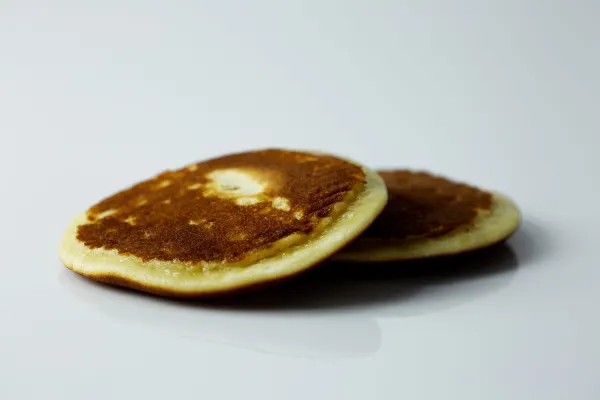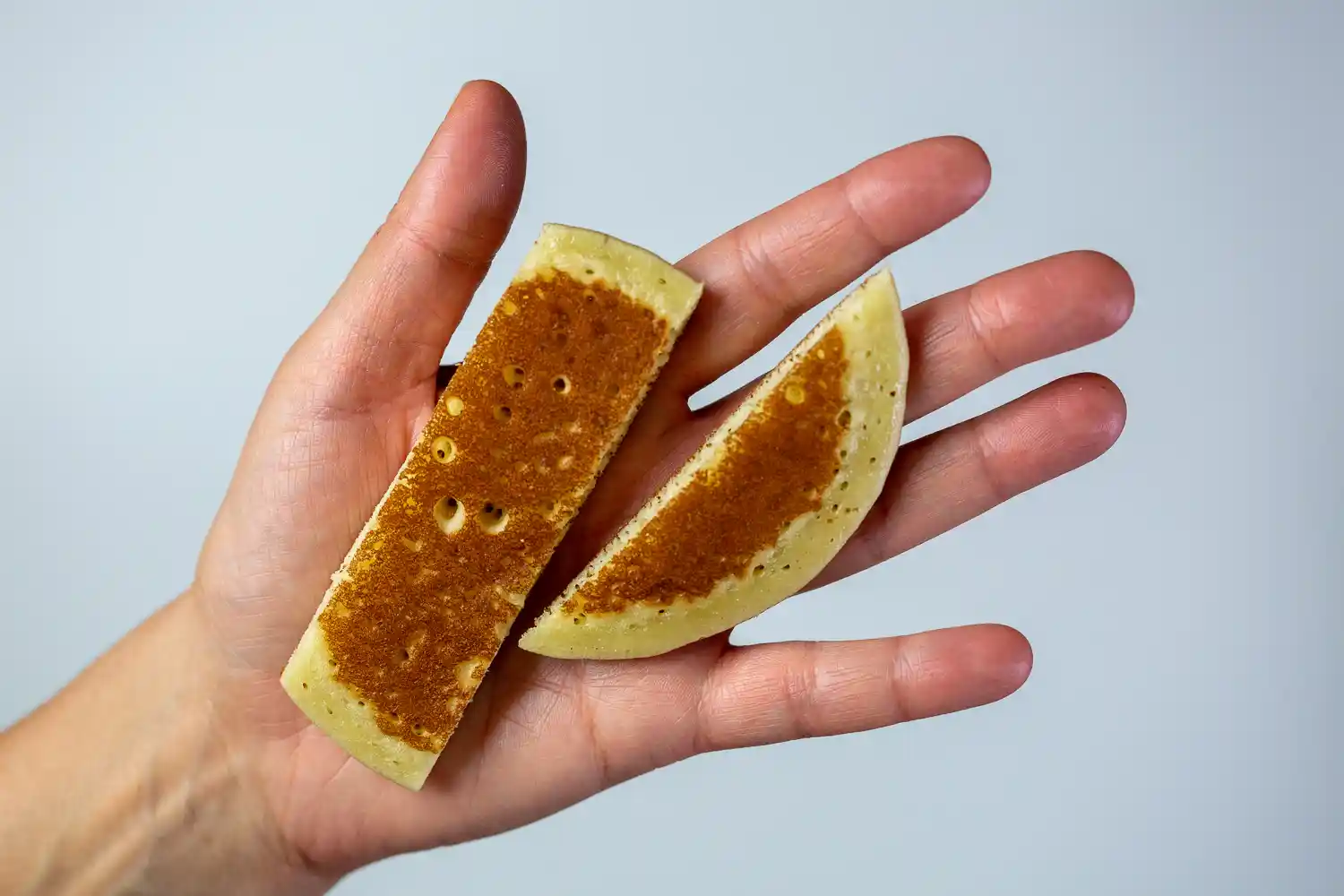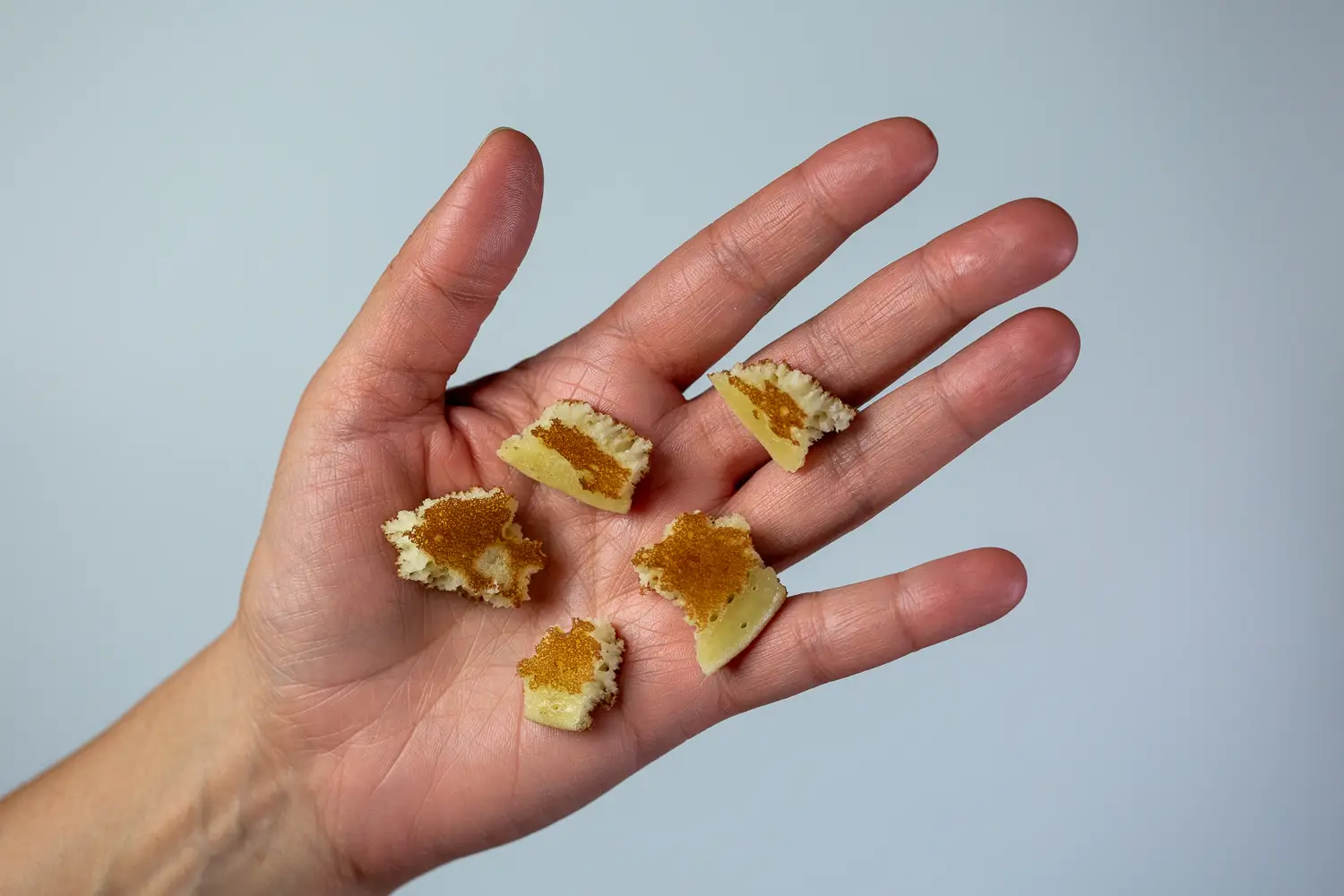Acceda a la base de datos First Foods® en Solid Starts App.
Leer másPanqueques
Comida preparada
Sugerencia de edades
6 meses
Alto contenido de hierro
No
Alérgeno común
Sí

When can babies have pancakes?
Pancakes may be introduced as soon as baby is ready to start solids, which is generally around 6 months of age, as long as they do not contain honey, which is associated with a risk of infant botulism.
Every culture has its own form of pancake, and most are made by combining ingredients to form a batter that gets fried to make thin cakes, but that is where the commonalities end. Pancakes are wildly diverse: there are buckwheat blini, delicate pancakes like crepes and injera, protein-packed pancakes like lentil cheela and dosa, vegetable pancakes like potato latkes and yachaejeon, and of course, the fluffy American-style pancakes enjoyed at diners and dinner tables alike.
¿Cómo ofrecer panqueques a los bebés?
Cada bebé se desarrolla a su propio ritmo, y las sugerencias que ofrecemos sobre cómo cortar o preparar determinados alimentos son generalizaciones para una amplia audiencia.
6 months old +:
Offer strips of pancake about the size of two adult fingers pressed together. If baby doesn’t seem interested or has trouble picking up the food, hold a strip in the air and let the child grab it from you. Pancakes with a crispier exterior (such as freshly cooked or toasted pancakes) are less likely to gum up in baby’s mouth than pancakes that are softer or more dry. Adding butter or a thin spread of applesauce or yogurt to a very dry pancake can help decrease gagging. Thin-style pancakes like crepe, dosa, and injera can be shared with baby, too. Just keep in mind that they can easily stick to the tongue as they are moistened with saliva, which may cause more gagging, and a strip of a thin-style pancake easily falls apart as baby grips it. If a pancake strip gets too small and makes you uncomfortable, swap it out for a new strip. Avoid pancakes that contain or are topped with honey, due to the risk of infant botulism.
9 months old +:
Serve any type of pancake cut into bite-sized pieces or continue to offer pancake strips for biting and tearing practice. If baby is overstuffing their mouth, try serving one bite-sized piece or pancake strip at a time. If the pancakes contain vegetables, reduce the risk of choking by shredding the vegetables or cooking them until they are very soft before mixing them into the batter. Avoid pancakes that contain or are topped with honey, due to the risk of infant botulism.
12 months old +:
Continue to serve any type of pancake in strips or bite-sized pieces. At this age, you can also serve a whole pancake for practice taking bites. Feel free to serve pancakes with an age-appropriate utensil, but don’t expect accurate and consistent utensil use until a child is older (closer to age 2 or 3).


Videos
Are pancakes a choking hazard for babies?
No. Pancakes present a low risk when safely prepared for a child’s age and developmental ability, though, in theory, an individual could choke on any food. To reduce the risk, prepare and serve pancakes in an age-appropriate way as described in the How to Serve section. Note that pancakes, especially when dry, can get sticky in the mouth when mixed with saliva and can cause baby to gag. Serving alongside a cup of water can help. As always, create a safe eating environment and stay within reach of baby during meals.
Learn the signs of choking and more about choking first aid in our free guides, Infant Rescue and Toddler Rescue.
Do pancakes contain common allergens?
Yes. Pancakes are often made with wheat, dairy, and eggs, and may also include other common food allergens such as soy, peanut, tree nuts, seafood (like shrimp), or sesame depending on the type of pancakes.
You will have more control over the ingredients when preparing pancakes from scratch at home. When you want to offer pre-made pancakes, be mindful of food allergies and check the ingredient list carefully every time. Ingredients and recipes vary from one pre-made pancake to another.
Prior to sharing pancakes with baby, it is important to introduce common food allergens on their own and rule them out as allergens before serving them together in a prepared food. This way, you’ll be able to identify which allergen is responsible if baby has a reaction. Then, when you are ready to offer pancakes, you will be confident that they have already safely eaten any common food allergens in the dish.
As you would when introducing any new food, start by offering a small quantity for the first few servings. If there is no adverse reaction, gradually increase the quantity over future meals.
Are pancakes healthy for babies?
Yes. Pancakes usually offer carbohydrates, as well as some protein and fat. They can also contain a variety of micronutrients, like calcium, iron, folate, and B vitamins, and other vitamins and minerals. These nutrients work to provide energy for growth, play, and exploration, in addition to supporting bone health, red blood cells, neurodevelopment, metabolic processes, and more.
When serving pancakes to baby, avoid the addition of honey, which poses a rare risk of infant botulism to babies under 12 months of age.
Can babies have pancakes from boxed mixes?
Yes. While boxed pancakes can be high in sodium and/or sugar, the amount that babies eat tends to be low as they learn the skills to feed themselves, and some sodium is important for supporting baby’s electrolyte balance, hydration, and movement. Pancakes from a boxed mix are fine to offer as part of a variety of foods in the diet.
Nuestro equipo
Escrito por
Consejos de expertos directo a tu bandeja de entrada
¡Suscríbete y recibe correos semanales con recetas, consejos y más!
Copyright © 2025 • Solid Starts Inc







